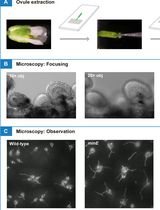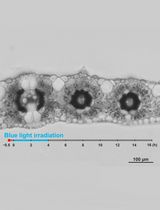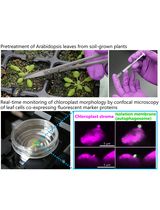- EN - English
- CN - 中文
A Protocol for Mitotic Metaphase Chromosome Count Using Shoot Meristematic Tissues of Mulberry Tree Species
利用桑树枝条分生组织进行有丝分裂中期染色体计数的方案
(*contributed equally to this work) 发布: 2023年09月05日第13卷第17期 DOI: 10.21769/BioProtoc.4643 浏览次数: 2595
评审: Wenrong HeAnuradha SinghAnonymous reviewer(s)
Abstract
Studies on chromosomal status are a fundamental aspect of plant cytogenetics and breeding because changes in number, size, and shape of chromosomes determine plant physiology/performance. Despite its significance, the classical cytogenetic study is now frequently avoided because of its tedious job. In general, root meristems are used to study the mitotic chromosome number, even though the use of root tips was restricted because of sample availability, processing, and lack of standard protocols. Moreover, to date, a protocol using shoot tips to estimate chromosome number has not yet been achieved for tree species’ germplasm with a large number of accessions, like mulberry (Morus spp.). Here, we provide a step-by-step, economically feasible protocol for the pretreatment, fixation, enzymatic treatment, staining, and squashing of meristematic shoot tips. The protocol is validated with worldwide collections of 200 core set accessions with a higher level of ploidy variation, namely diploid (2n = 2x = 28), triploid (2n = 3x = 42), tetraploid (2n = 4x = 56), hexaploid (2n = 6x = 84), and decosaploid (2n = 22x = 308) belonging to nine species of Morus spp. Furthermore, accession from each ploidy group was subjected to flow cytometry (FCM) analysis for confirmation. The present protocol will help to optimize metaphase plate preparation and estimation of chromosome number using meristematic shoot tips of tree species regardless of their sex, location, and/or resources.
Keywords: Chromosome number (染色体数)Background
The plant genome is organized into chromosomes, preserving hereditary information and facilitating its replication, transcription, and transfer. One of the fundamental aspects of plant evolutionary biology is to understand the genome organization and its functional aspects that directly or indirectly act in concert with plant adaptability. Chromosomal studies imply a historical impression of natural consequences, for example, the patterns of chromosomal evolution influenced by factors like natural/artificial selection pressure or crop domestication (Tang et al., 2010). The evolution of chromosome size, structure, and number and the change in DNA composition suggest high plasticity of nuclear genomes at the chromosomal level (Guerra, 2008). In the recent past, integrated cytogenetics, chromosome-level sequencing, and comparative analysis were implemented to grasp the essential component of the evolutionary mechanisms of plant genomes. There are approximately 450,000 species of green plants, but only approximately 300 genome assemblies at the chromosome-scale, corresponding to 812 species (Arita et al., 2021; Kress et al., 2022). Additionally, polyploidy (or whole-genome duplication, WGD) is considered an evolutionary and ecological force in times of stress adaptation (Van de Peer et al., 2021). Hence, chromosomal information has significant importance in plant breeding, genetic, and biotechnological studies including chromosome-scale genome assembly, which can complement molecular phylogeny towards the understanding of complex evolutionary consequences.
Despite its significance, the estimation of chromosome numbers using the squash technique has been restricted (Goldblatt, 2007). For the majority of monocots, root tips are widely used to study the mitotic chromosome number, as the use of shoot tips is laborious, and squashing reduces the spread quality (Anamthawat-Jónsson, 2003). However, mitotic metaphase plate preparation using root tips or floral tissues present considerable disadvantages, specifically for tree plants: (a) living material with actively growing tissues, like meristems, are prerequisite (Guerra, 2008), and the collation of meristematic root tips from the mature tree plant is not easy (Sinha et al., 2016), (b) seed-derived root tips do not represent the same chromosome complements as their mother trees, because of introgressive hybridization (Anamthawat-Jónsson, 2003), (c) grafted plants do not comprise a true root system; hence, chromosomal study is difficult, and (d) the availability of floral tissues depends on the favorable season (Anamthawat-Jónsson, 2003). On the other hand, metaphase plate preparation using shoot meristematic tips present major advantages compared to root tips or floral tissues: (a) ease of collecting intact healthy explants from plants; (b) shoot tips tend to have less condensed chromosomes, and longer or extended chromosomes are desirable as the mapping resolution will be better (Anamthawat-Jónsson, 2003); further, for a highly heterozygous crop like mulberry, the chromosome size and number show huge variations (Datta et al., 1954), and shoot tips could be precious explants to estimate the chromosome number of higher ploidy plants; and (c) for recalcitrant seeds as well as endangered tree species, shoot tips of original mother plants may serve the purpose.
So far, published articles/protocols using shoot tips are very limited; cytogenetics cannot be applied in population studies unless samples are obtained from actual plants in the field, because chromosome number varies among the progeny (Anamthawat-Jónsson, 2003). Recently, Chang et al. (2018) suggested that the small size of chromosomes of mulberry also limits distinguishing euploid/aneuploid, and karyotypic analysis could help identifying different ploidy. It is, therefore, necessary to develop a standard, economically feasible base protocol for the screening and characterization of large-scale germplasm accessions. In addition, high-cost flow cytometry (FCM) analysis for large-scale accessions of germplasm may not be affordable for all researchers (Windham et al., 2020). This barrier is exacerbated by a lack of sufficient details on critical aspects of the protocol like tissue choice, maceration, and squashing (Windham et al., 2020).
Mulberry (Morus spp.) has been commercially exploited as the host of the monophagous pest silkworm (Bombyx mori L.). It belongs to the Moraceae family, which comprises 37 genera, with more than 1,100 species (Clement and Weiblen, 2009). The genus Morus has over 10 species with more than 1,000 cultivated varieties spanning Asia, Europe, Africa, and the United States (He et al., 2013). Efforts were made to classify Morus species; however, to date, taxonomic nomenclature remains doubtful. Besides, genetics of inheritance are also complicated in Morus species due to the higher level of heterozygosity as well as WGD (Jain et al., 2022). Mulberry has a wide range of polyploidy; for example, M. notabilis was reported as a haploid, having a chromosome complement of 2n = x = 14 (He et al., 2013), while M. alba, M. atropurpurea, M. bombycis, M. indica, M. latifolia, and M. rotundiloba were considered diploids, having 2n = 2x = 28 (Datta, 1954). The majority of triploids (2n = 3x = 42) and tetraploids (2n = 4x = 56) have been identified in M. laevigata (Das, 1961). Hexaploid species (2n = 6x = 84), such as thick leaf M. serrata (Basavaiah et al., 1989) and M. tiliaefolia (Seki, 1952), are also recognized; the ploidy can extend up to decosaploid (2n = 22x = 308), as in M. nigra (Basavaiah et al., 1990).
The generation of chromosomal/ploidy-related information of non-model tree plants like mulberry, where the occurrence of polyploidization is common, can be a logistic strategy to create a foundation for future molecular cytogenetics and next-generation sequencing–based work, toward potential crop development and conservation. In this context, the metaphase chromosome number of 200 germplasm accessions of different accessible Morus spp. was counted using shoot meristematic tissue. Accessions were obtained from the Central Sericultural Germplasm Resources Centre (CSGRC), Hosur, India. Hopefully, the present protocol will help to optimize metaphase plate preparation and chromosome number estimation using meristematic shoot tips of tree species regardless of sex, location, and/or resources.
Materials and reagents
Consumables
Eppendorf tubes, 1.5 mL (Tarsons, India)
Reagent bottles, amber 25 mL (Borosil, catalog number: 1519009)
Glass slides, 76 mm × 26 mm (Borosil, Product code 9100P02)
Coverslip, rectangular, 24 mm × 60 mm (Blue Star, India)
Aluminum foil, 72 m (Century, India)
Dissecting needle (Labkafe, India Product code: LKBI 008/1)
Plant Material
Tree plants approximately 15 years old, maintained at CSGRC’s field gene bank, of different cytotypes as diploids (MI-0014 and MI-0308), triploids (MI-0173 and MI-0799), tetraploids (K2-4X), hexaploids (ME-0126, MI-0426, and MI-0571), and decosaploid (ME-0241) were selected for this study. In the present protocol, for metaphase chromosome count, apical shoot meristematic tips were collected after 20 days of pruning.
Reagents
Sterile, double-distilled water (ddH2O)
100% glacial acetic acid (Rankem, catalog number: A0031)
0.5 M ethylenediaminetetraacetic acid (EDTA) (GeNei, catalog number: FC43)
Ethanol (HiMedia, catalog number: MB106)
Potassium chloride (KCl) (HiMedia, catalog number: PCT0012)
2.5 (w/v) pectinase (HiMedia, catalog number: PCT1519)
2.5 (w/v) pectolyase (HiMedia, catalog number: PCT1520)
1:1 (v/v) cellulase (HiMedia, catalog number: RM3331)
1% acetocarmine (HiMedia, catalog number: PCT1304)
1% Orcein (HiMedia, catalog number: RM277)
Saturated para-dichlorobenzene (PDB) (HiMedia, catalog number: GRM6907) (see Recipes)
0.002 M 8-hydroxyquinoline (HQ) (HiMedia, catalog number: GRM7135) (see Recipes)
45% GAA (glacial acetic acid) (see Recipes)
70% ethanol (see Recipes)
3EtOH:1GAA (see Recipes)
75 mM KCl (see Recipes)
Enzyme cocktail (see Recipes)
1% aceto-orcein (see Recipes)
Equipment
Surgical blade, size 22 (Surgeon, India, REF 10122)
Personal protection equipment (Oriley, model: ORPPE6), including gloves (model: KSN30) and safety glasses (Augen, model: safety glass-SG-03)
Ice flaker (PAREX, PSW-130)
Squeeze bottle (Borosil, model: 0166024)
Highly absorbent blotting paper (Swastik, India)
Forceps, pointed, 5" (Borosil, model: LAFP8888005)
Minicooler (Tarson, model: 525060)
Incubator (ESCO, model: CCL-050B-8)
Micropipette (Eppendorf)
Freezer (Whirlpool, model: ICEMAGIC FF-350)
Stereo zoom microscope (Leica, model: Wild M8-308700)
Portable digital microscope (Medprime, model: BT-E2020) with iPad (AppleInc.)
iMac 27’’ M1 chip-macOS Monterey (Apple Inc.)
Sankalp immersion oil (Oil LV, model: 1017)
Spirit lamp (HiMedia, model: LA275)
Sealing wax (Alpha Chemika, model: AL2934)
Software
Cilika (Version 1.30), Medprime Technology Pvt. Ltd. (www.medprimetech.com), image capture software
Microsoft Excel, Microsoft
Keynote presentation software (Apple Inc. Version 10)
Floreada.io (https://floreada.io/flow-cytometry-software)
Procedure
文章信息
版权信息
© 2023 The Author(s); This is an open access article under the CC BY-NC license (https://creativecommons.org/licenses/by-nc/4.0/).
如何引用
Mondal, R., Antony, S., Gnanesh, B. N., Thanavendan, G., Ravikumar, G., Sreenivasa, B. T., Gandhi Doss, S. and Vijayan, K. (2023). A Protocol for Mitotic Metaphase Chromosome Count Using Shoot Meristematic Tissues of Mulberry Tree Species. Bio-protocol 13(17): e4643. DOI: 10.21769/BioProtoc.4643.
分类
植物科学 > 植物细胞生物学 > 细胞成像
植物科学 > 植物分子生物学 > 染色质
您对这篇实验方法有问题吗?
在此处发布您的问题,我们将邀请本文作者来回答。同时,我们会将您的问题发布到Bio-protocol Exchange,以便寻求社区成员的帮助。
Share
Bluesky
X
Copy link














